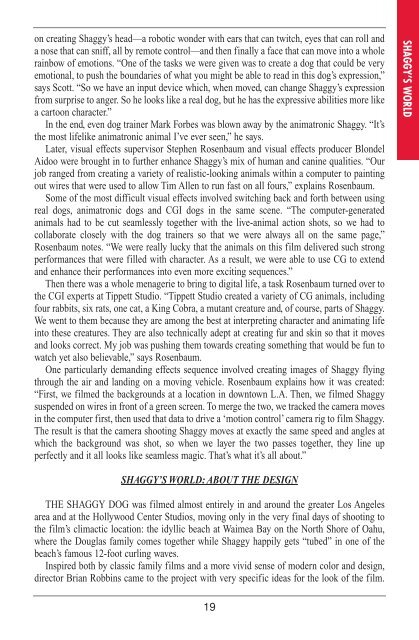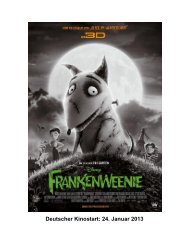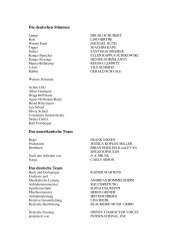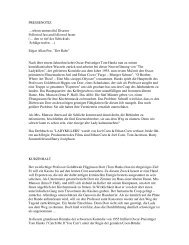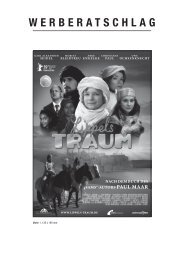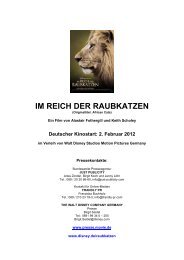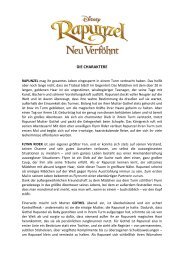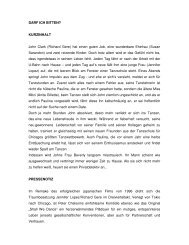the shaggy dog - Walt Disney Studios Motion Pictures Germany
the shaggy dog - Walt Disney Studios Motion Pictures Germany
the shaggy dog - Walt Disney Studios Motion Pictures Germany
Create successful ePaper yourself
Turn your PDF publications into a flip-book with our unique Google optimized e-Paper software.
on creating Shaggy’s head—a robotic wonder with ears that can twitch, eyes that can roll and<br />
a nose that can sniff, all by remote control—and <strong>the</strong>n finally a face that can move into a whole<br />
rainbow of emotions. “One of <strong>the</strong> tasks we were given was to create a <strong>dog</strong> that could be very<br />
emotional, to push <strong>the</strong> boundaries of what you might be able to read in this <strong>dog</strong>’s expression,”<br />
says Scott. “So we have an input device which, when moved, can change Shaggy’s expression<br />
from surprise to anger. So he looks like a real <strong>dog</strong>, but he has <strong>the</strong> expressive abilities more like<br />
a cartoon character.”<br />
In <strong>the</strong> end, even <strong>dog</strong> trainer Mark Forbes was blown away by <strong>the</strong> animatronic Shaggy. “It’s<br />
<strong>the</strong> most lifelike animatronic animal I’ve ever seen,” he says.<br />
Later, visual effects supervisor Stephen Rosenbaum and visual effects producer Blondel<br />
Aidoo were brought in to fur<strong>the</strong>r enhance Shaggy’s mix of human and canine qualities. “Our<br />
job ranged from creating a variety of realistic-looking animals within a computer to painting<br />
out wires that were used to allow Tim Allen to run fast on all fours,” explains Rosenbaum.<br />
Some of <strong>the</strong> most difficult visual effects involved switching back and forth between using<br />
real <strong>dog</strong>s, animatronic <strong>dog</strong>s and CGI <strong>dog</strong>s in <strong>the</strong> same scene. “The computer-generated<br />
animals had to be cut seamlessly toge<strong>the</strong>r with <strong>the</strong> live-animal action shots, so we had to<br />
collaborate closely with <strong>the</strong> <strong>dog</strong> trainers so that we were always all on <strong>the</strong> same page,”<br />
Rosenbaum notes. “We were really lucky that <strong>the</strong> animals on this film delivered such strong<br />
performances that were filled with character. As a result, we were able to use CG to extend<br />
and enhance <strong>the</strong>ir performances into even more exciting sequences.”<br />
Then <strong>the</strong>re was a whole menagerie to bring to digital life, a task Rosenbaum turned over to<br />
<strong>the</strong> CGI experts at Tippett Studio. “Tippett Studio created a variety of CG animals, including<br />
four rabbits, six rats, one cat, a King Cobra, a mutant creature and, of course, parts of Shaggy.<br />
We went to <strong>the</strong>m because <strong>the</strong>y are among <strong>the</strong> best at interpreting character and animating life<br />
into <strong>the</strong>se creatures. They are also technically adept at creating fur and skin so that it moves<br />
and looks correct. My job was pushing <strong>the</strong>m towards creating something that would be fun to<br />
watch yet also believable,” says Rosenbaum.<br />
One particularly demanding effects sequence involved creating images of Shaggy flying<br />
through <strong>the</strong> air and landing on a moving vehicle. Rosenbaum explains how it was created:<br />
“First, we filmed <strong>the</strong> backgrounds at a location in downtown L.A. Then, we filmed Shaggy<br />
suspended on wires in front of a green screen. To merge <strong>the</strong> two, we tracked <strong>the</strong> camera moves<br />
in <strong>the</strong> computer first, <strong>the</strong>n used that data to drive a ‘motion control’ camera rig to film Shaggy.<br />
The result is that <strong>the</strong> camera shooting Shaggy moves at exactly <strong>the</strong> same speed and angles at<br />
which <strong>the</strong> background was shot, so when we layer <strong>the</strong> two passes toge<strong>the</strong>r, <strong>the</strong>y line up<br />
perfectly and it all looks like seamless magic. That’s what it’s all about.”<br />
SHAGGY’S WORLD: ABOUT THE DESIGN<br />
THE SHAGGY DOG was filmed almost entirely in and around <strong>the</strong> greater Los Angeles<br />
area and at <strong>the</strong> Hollywood Center <strong>Studios</strong>, moving only in <strong>the</strong> very final days of shooting to<br />
<strong>the</strong> film’s climactic location: <strong>the</strong> idyllic beach at Waimea Bay on <strong>the</strong> North Shore of Oahu,<br />
where <strong>the</strong> Douglas family comes toge<strong>the</strong>r while Shaggy happily gets “tubed” in one of <strong>the</strong><br />
beach’s famous 12-foot curling waves.<br />
Inspired both by classic family films and a more vivid sense of modern color and design,<br />
director Brian Robbins came to <strong>the</strong> project with very specific ideas for <strong>the</strong> look of <strong>the</strong> film.<br />
19<br />
SHAGGY’S WORLD


